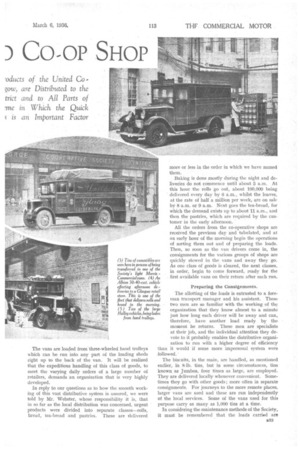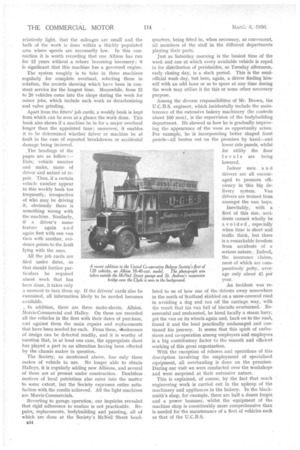FROM OVEN
Page 42

Page 43

Page 44

If you've noticed an error in this article please click here to report it so we can fix it.
) Co-OP SHOP 0 PERATING about 120 vehicles, the United Co-operative Baking Society, Ltd., of Glasgow, may be classed as one of that city's large ancillary users. The chief function of its delivery department is the distribution to the many co-operative shops in and around Glasgow (and in some cases up to a radius of 25 miles) of the numerous products of its bakeries. In addition, it transports biscuits, which do not rank as perishable goods and which, therefore, have not to be rushed so urgently straight from the oven to the table, to comparatively remote parts of Scotland.
An idea of the magnitude of the undertaking can be formed from figures quoted to us by Mr. Webster, the Society's distribution and transport manager : 3,000 gallons of petrol are supplied per week by the Anglo-American Oil . Co., Ltd. ; 42,000 8-1b. tins of biscuits were sent but during the week prior to our visit ; on an average, between 2,000 and 3,000 trays of pastries are distributed daily, this figure reaching 5,000 to 6,000, on certain days.
The Transport of Raw Materials.
Besides delivery, there is also the work of bringing in to headquarters from docks, railway stations, and mills, the raw materials, among which predominate flour for the bakery and fuel for the furnaces.
For the past 10 years motor vehicles have been used exclusively for all these purposes, and in the main, 25-40-cwt. machines are employed. There are, however, larger vehicles, the biggest being 4-tanners. All operate under C licences. The fleet comprises 61 Albions, 36 Halleys and 23 Morris-Commercials.
All those vehicles used for the transport of bakery products have van bodies built by U.C.B.S. These are specially made for the accommodation of confectionery trays and bread boards, being equipped inside with angle-iron runners upon which 50 boards in a 30-40-cwt. van and 25 in the lighter vehicles are supported. The runners are arranged to take a one-board-width longitudinal tier and the remainder are stacked transversely ; thus all the available space can be used to full advanta ve.
B32 Most of the vans have two half-height ventilating doors, horizontally hinged along their lower edges. Vans for the biscuit trade are equipped for side as well as end loading, and sided or platform lorries are employed for flour, coal and so forth.
Loading is an important item of procedure, for there is no time to be wasted from the moment the goods leave the oven. The bread is all handled on boards of standard size, each of which carries two dozen 2-lb loaves, and the pastries, etc., in trays, each having a base that fits snugly into the top of the tray below it, so that they can be arranged and moved about in tiers with security. The vans are loaded from'three-wheeled hand trolleys which can be run into any part of the loading sheds right up to the back of the van. It will be realized that the expeditious handling of this class of goods, to meet the varying daily orders of a large number of retailers, demands an organization that is very highly developed.
In reply to our questions as to how the smooth working of this vast distributive system is assured, we were told by Mr. Webster, whose responsibility it is, that in so far as the local distribution was concerned, urgent products were divided into separate classes—rolls, bread, tea-bread and pastries. These are delivered more or less in the order in which we have named them.
Baking is done mostly during the night and deliveries do not commence until about 5 a.m. At this hour the rolls go out, about 100,000 being delivered every day by 6 a.m., whilst the loaves, at the rate of half a million per week, are on sale by 8 a.m. or 9 a.m. Next goes the tea-bread, for which the demand exists up to about 11 a.m., and then the pastries, which are required by the customer in the early afternoon.
Ail the orders from the co-Operative shops are received the previous day and tabulated, and at an early hour of the morning begin the operations of sorting them out and of preparing the loads. Then, so soon as the van drivers come in, the consignments for the various groups of shops are quickly stowed in the vans and away they go. As one class of goods is cleared, the next classes, in order, begin to come forward, ready for the first available vans on their return after each rim.
Preparing the Consignments.
The allotting of the loads is entrusted to a foreman transport manager and his assistant. These two men are so familiar with the working of thc organization that they know almost to a minute just how long each driver will be away and can, therefore, have another load ready by the moment he returns. These men are specialists at their job, and the individual attention they devote to it probably enables the distributive,organiration to run with a higher degree of efficiency than it would if some more impersonal system were followed.
The biscuits, in the main, are handled, as mentioned earlier, in 8-lb. tins, but in some circumstances, tins known as Jumbos, four times as large, are employed. They are delivered locally whenever convenient. Sometimes they go with other goods; more often in separate consignments. For journeys to the more remote places-, larger vans are used and these are run independently of the local services. Some of the vans used for this purpose carry as many as 1,000 tins at a time.
In considering the maintenance methods of the Society, it must be remembered that the loads carried are B33
relatively light, that the mileages are small and the bulk of the work is done within a thickly populated area where speeds are necessarily low. In this connection it is worth recording that one Albion has run for 13 years.without a rebore becoming 'necessary ; it is significant that this machine has a governed engine.
The system roughly is to take in three machines regularly for complete overhaul, selecting them in rotation, the records showing which have been in constant service for the longest time. Meanwhile, from 15 to 20 vehicles come into the shops during the week for minor jobs, which include such work as decarbonizing and valve grinding.
Apart from the titters' job cards, a weekly book is kept from which can be seen at a glance the work done. This book also shows if a machine be in for a major overhaul longer than the appointed time ; moreover, it enables it to he determined whether driver or machine be at fault in the case of repeated breakdowns or accidental damage being incurred.
The headings of the pages are as follow :— Date, vehicle number and make, name of driver and nature-of repair. Thus, if a certain vehicle number appear in this weekly book too frequently, irrespective of who may be driving it, obviously there is something wrong with the machine. Similarly, if a driver's name feature again and again first with one vau then with another, evidence points to the fault lying with the man.
All the job cards are filed under dates, so that should further particulars be required about . work that has been done, it takes only a moment to turn them up. If the drivers' cards also be examined, all information likely to be needed becomes available.
In addition, there are three make-sheets, Albion, Morris-Commercial and Halley. On these are recorded all the vehicles in the fleet with their dates of purchase, and against them the main repairs and replacements that have been needed for each. From these, likaltnesses of design can be detected readily, and it is worthy of mention that, in at least one case, the appropriate sheet has played a part in an alteration having been effected by the chassis maker in question.
The Society, as mentioned above, has onlythree makes of vehicle in use. No longer able to obtain Halleys, it is regularly adding new Albions, and several of these are at present under construction. Doubtless motives of local patriotism also enter into the matter to some extent, but the Society expresses entire satisfaction with the results 'achieved. All the light machines are Morris-Commercials.
Reverting to garage operation, our inquiries revealed that rigid adherence to routine is not practicable. Repairs, replacements, bodybuilding and painting, all of which are done at the Society's McNeil Street head B34 quarters, being fitted in, when necessary, as convenient, all members of the staff in the different departments playing their parts.
Just as Saturday morning is the busiest time of the week and one at which every available vehicle is roped in for distribution of perishables, so Tuesday afternoon, early cloSing day, is a slack period. This is the semiofficial wash day, but here, again, a driver finding himself with an add hour or so to spare at any time during the week may utilize it for this or some other necessary purpose.
Among the diverse responsibilities of Mr. Brown, the U.C.B.S. engineer, which incidentally include the maintenance of the extensive bakery machinery•the controls about 100 men), is the supervision of the bodybuilding department. He showed us how he is gradually iniproving the appearance of the vans as opportunity arises. For example, he is incorporating better shaped front panels—all beaten out on the premises by hand—and lower side panels, whilst for utility the floor levels are being lowered.
Indoor men a n d drivers are all encouraged to promote efficiency in this big delivery system. Van drivers are trained from amongst the van boys.
Inevitably, with a fleet of this size, accidents cannot wholly be avoided, especially when time is short and traffic thick, but there is a remarkable freedom from accidents of a serious nature. Indeed, the insurance claims, most of which are comparativeli petty, average only about 45 per year.
An incident was related to us of how one of the drivers away somewhere in the north of Scotland skidded on a snow-covered road in avoiding a dog and ran off the carriage way, with the result that his van full of biscuits overturned. Resourceful and undaunted, he hired locally a steam lorry, got the van on its wheels again and, back on to the road, found it and the load practically undamaged and continued his journey. It seems that this spirit of enthusiasm and co-operation among employers and employees is a big contributory factor to the smooth and efficient working of this great organization.
With the exception of rebores and operations of this description involving the employment of specialized equipment, all overhauling is done on the premises. During our visit we were conducted over the workshops and were surprised at their extensive nature.
This is explained, of course, by the fact that much engineering work is carried out in the upkeep of the machinery and appliances in the bakery. In the blacksmith's shop, for example, there are half a dozen forges and a power hammer, whilst the equipment of the machine shop is considerably more comprehensive than is needed for the maintenance of a fleet of vehicles such as that of the U.C.B.S.




















































































